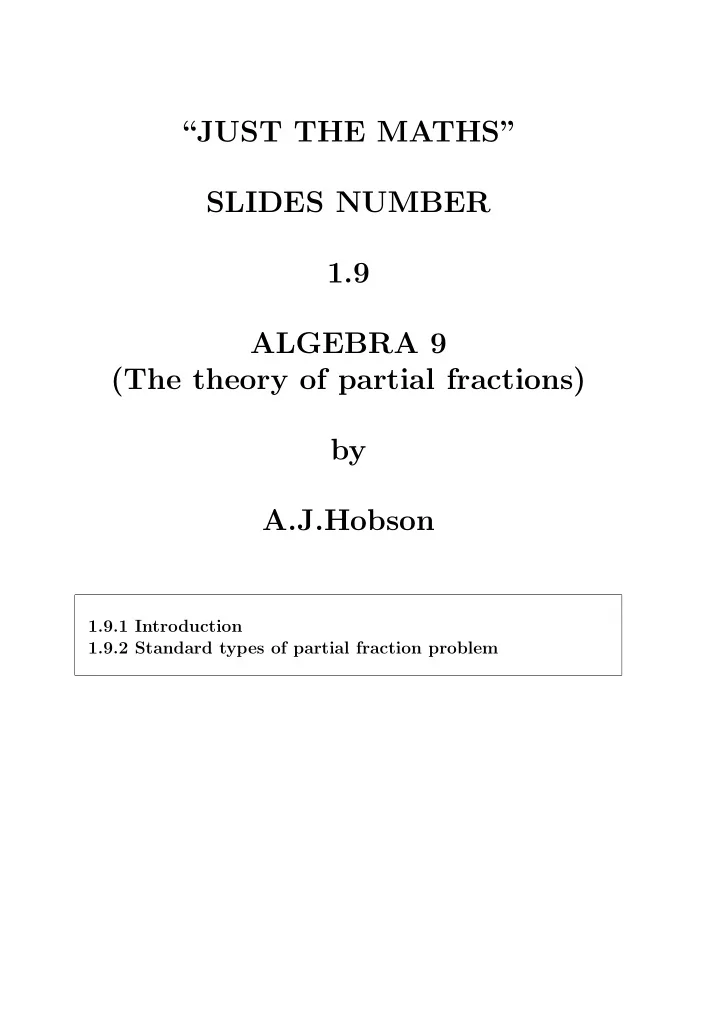

“JUST THE MATHS” SLIDES NUMBER 1.9 ALGEBRA 9 (The theory of partial fractions) by A.J.Hobson 1.9.1 Introduction 1.9.2 Standard types of partial fraction problem
UNIT 1.9 - ALGEBRA 9 THE THEORY OF PARTIAL FRACTIONS 1.9.1 INTRODUCTION Applies chiefly to a “Proper Rational Function” (numerator powers lower than denominator powers) “Improper Rational Function” = the sum of a polynomial and a proper rational function (by long di- vision) ILLUSTRATION 1 3 7 x + 8 2 x + 3 + (2 x + 3)( x − 1) . x − 1 ≡ 1.9.2 STANDARD TYPES OF PARTIAL FRACTION PROBLEM (a) Denominator of the given rational function has all linear factors. EXAMPLE 7 x + 8 A B 2 x + 3 + x − 1 . (2 x + 3)( x − 1) ≡ Solution 7 x + 8 ≡ A ( x − 1) + B (2 x + 3) . 1
Substituting x = 1 gives 7 + 8 = B (2 + 3) . Hence, B = 7 + 8 2 + 3 = 15 5 = 3 . Substituting x = − 3 2 gives 7 × − 3 2 + 8 = A ( − 3 2 − 1) . Hence, A = 7 × − 3 = − 5 2 + 8 2 = 1 . − 3 − 5 2 − 1 2 7 x + 8 1 3 (2 x + 3)( x − 1) = 2 x + 3 + x − 1 . Alternatively, use the “Cover-up” Rule (b) Denominator of the given rational function contains one linear and one quadratic factor EXAMPLE 3 x 2 + 9 Bx + C A x − 5 + x 2 + 2 x + 7 . ( x − 5)( x 2 + 2 x + 7) ≡ 2
Solution 3 x 2 + 9 ≡ A ( x 2 + 2 x + 7) + ( Bx + C )( x − 5) . x = 5 gives 3 × 5 2 + 9 = A (5 2 + 2 × 5 + 7); So, 84 = 42 A or A = 2. Equating coefficients of x 2 , 3 = A + B and hence B = 1. Equating constant terms (the coefficients of x 0 ), 9 = 7 A − 5 C = 14 − 5 C and hence C = 1. Therefore, 3 x 2 + 9 2 x + 1 x − 5 + x 2 + 2 x + 7 . ( x − 5)( x 2 + 2 x + 7) ≡ Note: A may be found by the cover-up rule, B and C by inspection. 3
(c) Denominator of the given rational function contains a repeated linear factor EXAMPLE 9 ( x + 1) 2 ( x − 2) . Solution First observe that Ax + B ( x + 1) 2 . may be written A ( x + 1) + B − A x + 1+ B − A A A C x + 1+ ( x + 1) 2 . ≡ ( x + 1) 2 ≡ ( x + 1) 2 Therefore, write 9 A C D x + 1 + ( x + 1) 2 + x − 2 . ( x + 1) 2 ( x − 2) ≡ 9 ≡ A ( x + 1)( x − 2) + C ( x − 2) + D ( x + 1) 2 . x = − 1 gives 9 = − 3 C so that C = − 3. x = 2 gives 9 = 9 D so that D = 1. 4
Equating coefficients of x 2 gives 0 = A + D so that A = − 1. Hence, 9 1 3 1 ( x + 1) 2 + x − 2 . ( x + 1) 2 ( x − 2) ≡ − x + 1 − Note: D could have been obtained by the cover-up rule. (d) Keily’s Method (uses Cover-up Rule) EXAMPLE 9 ( x + 1) 2 ( x − 2) . Solution 9 1 9 . ( x + 1) 2 ( x − 2) ≡ x + 1 ( x + 1)( x − 2) 1 − 3 3 . x + 1 + ≡ x + 1 x − 2 3 3 ( x + 1) 2 + ( x + 1)( x − 2) . ≡ − 3 1 1 x + 1 + ≡ − ( x + 1) 2 − x − 2 5
as before. Warning 9 x 2 ( x + 1) 2 ( x − 2) leads to an improper rational function 9 x 2 1 . x + 1 ( x + 1)( x − 2) 6
Recommend
More recommend